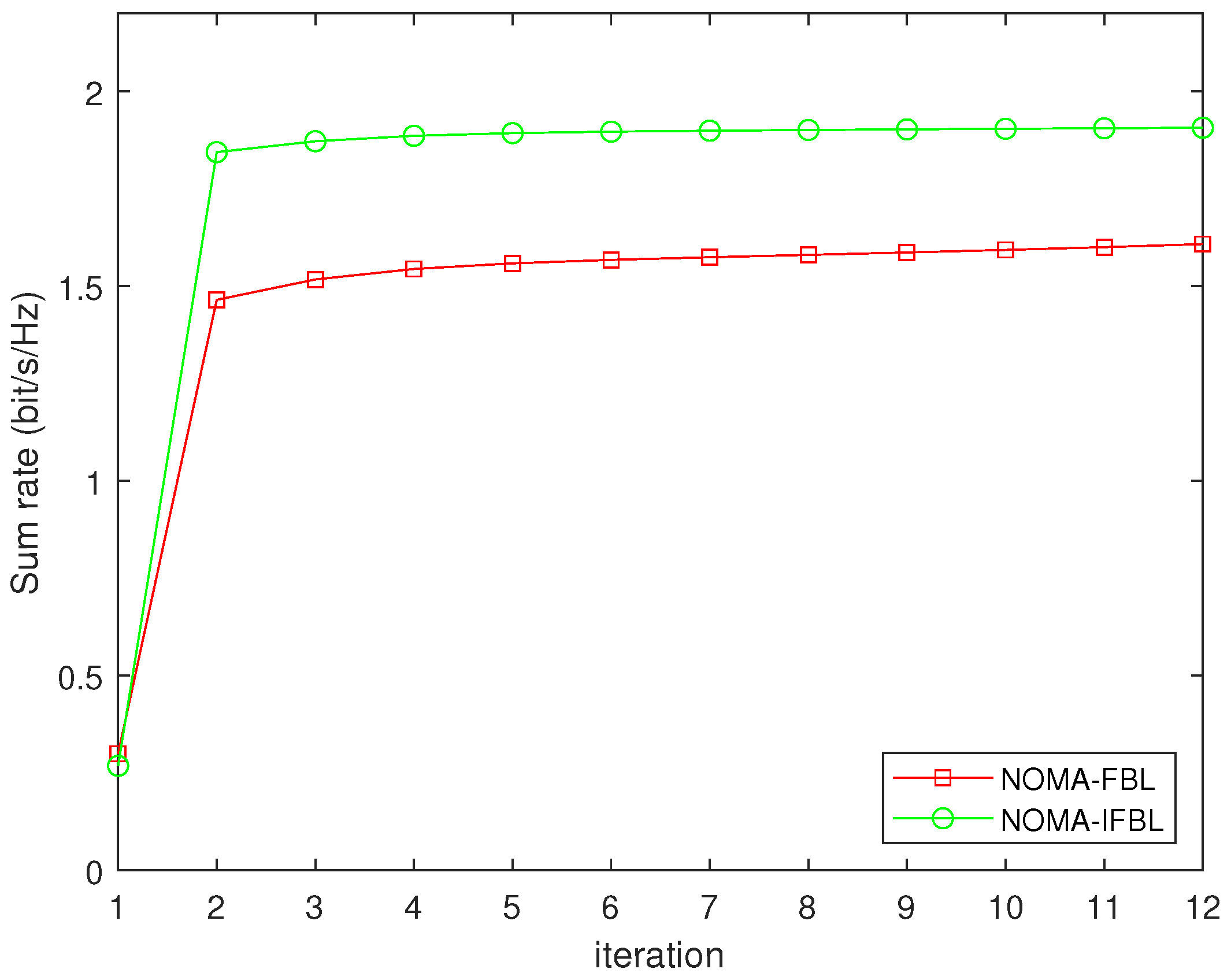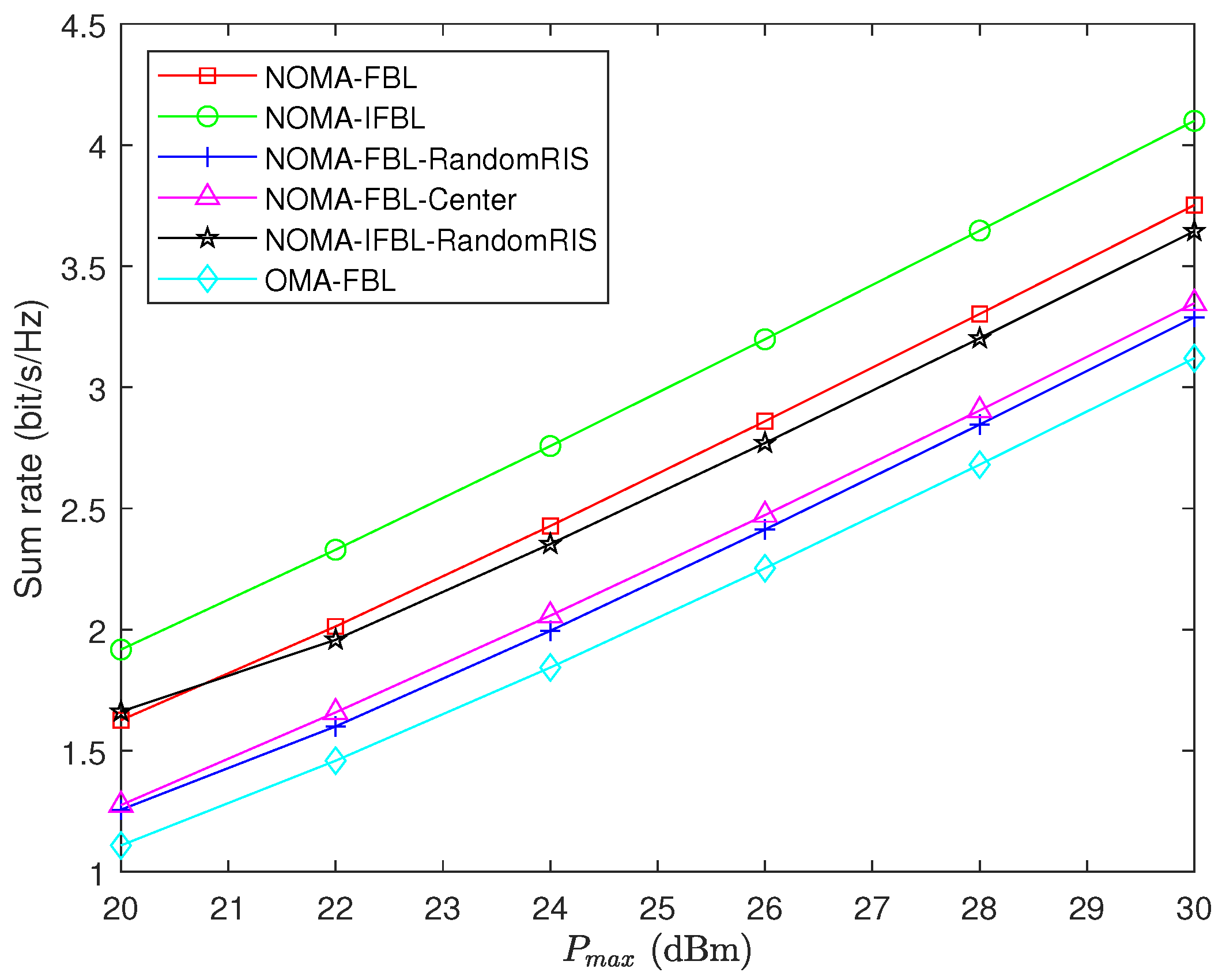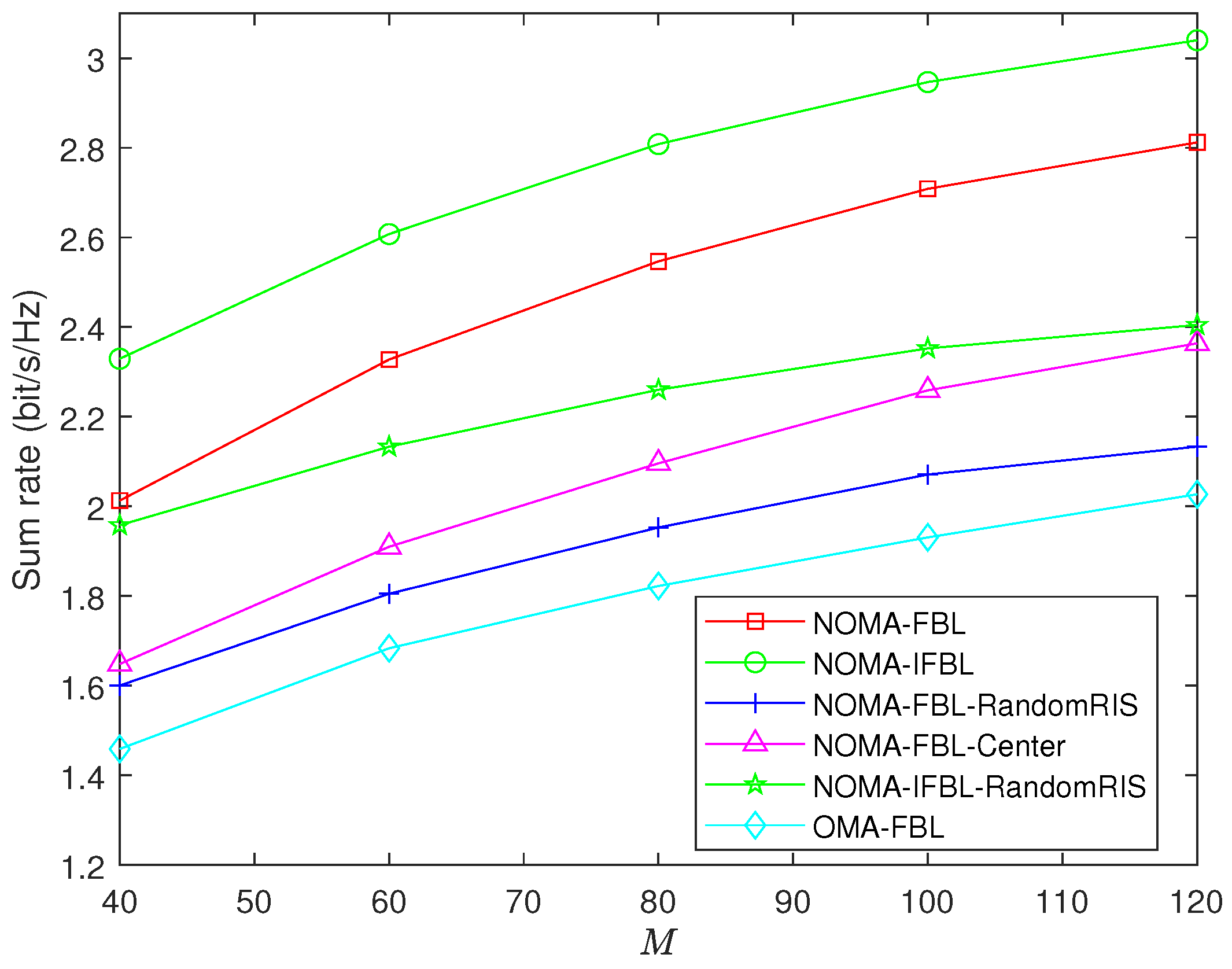Resource Allocation for UAV-RIS-Assisted NOMA-Based URLLC Systems
Abstract
1. Introduction
1.1. Related Work
1.2. Contributions and Novelty
2. System Model
3. Resource Allocation
3.1. Optimizing Power Allocation
3.2. Optimizing RIS Phase Shifts
3.3. Optimizing UAV-RIS Position and Decoding Order
3.4. Overall Algorithm Design and Convergence Analysis
| Algorithm 1 Proposed joint optimization algorithm |
|
4. Simulation Results
- NOMA-IFBL: In the case of infinite block length, we extend the two-user scenario presented in [28] to accommodate multiple users. The transmission rate is given byfor all , and the optimization variables are consistent with NOMA-FBL.
- NOMA-FBL-RandomRIS: In this case, we optimize power allocation, UAV-RIS position, and NOMA decoding order without optimizing the RIS phase shift.
- NOMA-FBL-Center: In this case, the UAV-RIS position is placed in the center of the BS and users center, with a height of 90 m. Variable optimization is the same as the NOMA-FBL algorithm, except for the UAV-RIS position and decoding order.
- NOMA-IFBL-RandomRIS: In the case, similar to NOMA-FBL-RandomRIS, all variables are optimized except the RIS phase shift.
- OMA-FBL: OMA technology is used in the FBL transmission scheme, similar to [37], and the transmission rate is given bywhere .
5. Conclusions
Author Contributions
Funding
Data Availability Statement
Conflicts of Interest
References
- Sutton, G.; Zeng, J.; Liu, R. Enabling Technologies for Ultra-Reliable and Low Latency Communications: From PHY and MAC Layer Perspectives. IEEE Commun. Surv. Tutor. 2019, 21, 2488–2524. [Google Scholar] [CrossRef]
- Li, X.; Yao, H.; Wang, J. A near-optimal UAV-aided radio coverage strategy for dense urban areas. IEEE Trans. Veh. Technol. 2019, 38, 9098–9109. [Google Scholar] [CrossRef]
- Wang, Z.; Hong, D.; Fan, Z. Resource allocation for UAV-assisted backscatter communication. EURASIP J. Wirel. Commun. 2022, 202, 104. [Google Scholar] [CrossRef]
- Ranjha, A.; Javed, M.; Srivastava, G. Intercell Interference Coordination for UAV enabled URLLC with perfect/imperfect CSI using cognitive radio. IEEE Open J. Commun. Soc. 2022, 4, 197–208. [Google Scholar] [CrossRef]
- Ranjha, A.; Kaddoum, G.; Dev, K. Facilitating URLLC in UAV-assisted relay systems with multiple-mobile robots for 6G networks: A prospective of agriculture 4.0. IEEE Trans. Ind. Inform. 2022, 18, 4954–4965. [Google Scholar] [CrossRef]
- Di, H.; Zhu, X.; Liu, Z. Joint Blocklength and Trajectory Optimizations for URLLC-enabled UAV Relay System. IEEE Commun. Lett. 2024, 28, 118–122. [Google Scholar] [CrossRef]
- Elwekeil, M.; Zappone, A.; Buzzi, S. Power control in cell-free massive MIMO networks for UAVs URLLC under the finite blocklength regime. IEEE Trans. Commun. 2023, 71, 1126–1140. [Google Scholar] [CrossRef]
- Chen, X.; Zhao, N.; Chang, Z.; Wang, X. UAV-aided secure short-packet data collection and transmission. IEEE Trans. Commun. 2023, 71, 2023. [Google Scholar] [CrossRef]
- Wu, Q.; Zhang, S.; Zheng, B.; You, C.; Zhang, R. Intelligent reflecting surface-aided wireless communications: A tutorial. IEEE Trans. Commun. 2021, 69, 3313–3351. [Google Scholar] [CrossRef]
- Lin, Z.; Niu, H.; An, K.; Hu, Y.; Li, D.; Wang, J. Pain without gain: Destructive beamforming from a malicious RIS perspective in IoT networks. IEEE IoT J. 2023, 11, 7619–7629. [Google Scholar] [CrossRef]
- Deshpande, R.; Katwe, M.; Singh, K.; Dinget, Z. Resource allocation design for spectral-efficient URLLC using RIS-aided FD-NOMA system. IEEE Wirel. Commun. Lett. 2023, 12, 1209–1213. [Google Scholar] [CrossRef]
- Hashemi, R.; Ali, S.; Mahmood, N. Deep reinforcement learning for practical phase-shift optimization in RIS-aided MISO URLLC systems. IEEE IoT J. 2022, 10, 8931–8943. [Google Scholar] [CrossRef]
- Abughalwa, M.; Tuan, H.; Nguyen, N.; Poor, V.; Hanzo, L. Finite-blocklength RIS-aided transmit beamforming. IEEE Trans. Veh. Technol. 2022, 71, 12374–12379. [Google Scholar] [CrossRef]
- Soleymani, M.; Santamaria, I.; Jorswieck, E.; Clerckx, B. Optimization of rate-splitting multiple access in beyond diagonal RIS-assisted URLLC systems. IEEE Trans. Wirel. Commun. 2024, 23, 5063–5078. [Google Scholar] [CrossRef]
- Ren, H.; Wang, K.; Pan, C. Intelligent reflecting surface-aided URLLC in a factory automation scenario. IEEE Trans. Commun. 2021, 70, 707–723. [Google Scholar] [CrossRef]
- Cao, K.; Tang, Q. Energy Efficiency Maximization for RIS-Assisted MISO Symbiotic Radio Systems Based on Deep Reinforcement Learning. IEEE Commun. Lett. 2024, 28, 88–92. [Google Scholar] [CrossRef]
- Wu, M.; Zhu, S.; Li, C.; Zhu, J.; Chen, Y.; Liu, X.; Liu, R. UAV-Mounted RIS-Aided Mobile Edge Computing System: A DDQN-Based Optimization Approach. Drones 2024, 8, 184. [Google Scholar] [CrossRef]
- Cheng, T.; Wang, B.; Cao, K.; Dong, R.; Diao, D. IRS-Assisted Secure UAV Communication System for Multiuser With Hardware Impairments. IEEE Syst. J. 2023, 17, 4946–4957. [Google Scholar] [CrossRef]
- Bansal, A.; Agrawal, N.; Singh, K.; Li, P.; Mumtaz, S. RIS selection scheme for UAV-based multi-RIS-aided multiuser downlink network with imperfect and outdated CSI. IEEE Trans. Commun. 2023, 71, 4650–4664. [Google Scholar] [CrossRef]
- Qin, X.; Song, Z.; Hou, T.; Wang, J.; Sun, X. Joint optimization of resource allocation, phase shift and UAV trajectory for energy-efficient RIS-assisted UAV-enabled MEC systems. IEEE Trans. Green Commun. Netw. 2023, 7, 1778–1792. [Google Scholar] [CrossRef]
- Singh, S.; Agrawal, K.; Singh, K.; Li, P.; Ding, Z. NOMA enhanced hybrid RIS-UAV-assisted full-duplex communication system with imperfect SIC and CSI. IEEE Trans. Commun. 2022, 70, 7609–7627. [Google Scholar] [CrossRef]
- Lai, H.; Li, D.; Xu, F.; Wang, X.; Ning, J.; Hu, Y.; Duo, B. Optimization of Full-Duplex UAV Secure Communication with the Aid of RIS. Drones 2023, 7, 591. [Google Scholar] [CrossRef]
- Pang, X.; Zhao, N.; Tang, J.; Wu, C.; Niyato, D.; Wong, K. IRS-assisted secure UAV transmission via joint trajectory and beamforming design. IEEE Trans. Commun. 2022, 70, 1140–1152. [Google Scholar] [CrossRef]
- Zhang, Q.; Zhao, J.; Zhang, R.; Yang, L. Downlink Transmissions of UAV-RIS-Assisted Cell-Free Massive MIMO Systems: Location and Trajectory Optimization. Sensors 2024, 24, 4064. [Google Scholar] [CrossRef]
- Ranjha, A.; Kaddoum, G. URLLC facilitated by mobile UAV relay and RIS: A joint design of passive beamforming, blocklength, and UAV positioning. IEEE IoT J. 2021, 8, 4618–4627. [Google Scholar] [CrossRef]
- Wei, L.; Wang, K.; Pan, C.; Elkashlan, M. Average Error Probability for UAV-RIS Enabled Short Packet Communications. IEEE Trans. Veh. Technol. 2024, 73, 2912–2917. [Google Scholar] [CrossRef]
- Singh, S.; Agrawal, K.; Singh, K.; Clerckx, B.; Li, B. RSMA for hybrid RIS-UAV-aided full-duplex communications with finite blocklength codes under imperfect SIC. IEEE Trans. Wirel. Commun. 2023, 22, 5957–5975. [Google Scholar] [CrossRef]
- Zhao, H.; Kong, Z.; Huang, H. Air reconfigurable intelligent surface enhanced multi-user noma system. IEEE IoT J. 2024, 11, 29–39. [Google Scholar]
- Al-Hourani, A.; Kandeepan, S.; Lardner, S. Optimal LAP altitude for maximum coverage. IEEE Wirel. Commun. Lett. 2014, 3, 569–572. [Google Scholar] [CrossRef]
- Ren, H.; Zhang, Z.; Peng, Z.; Li, L.; Pan, C. Energy minimization in RIS-assisted UAV-enabled wireless power transfer systems. IEEE IoT J. 2023, 10, 5794–5809. [Google Scholar] [CrossRef]
- Mu, X.; Liu, Y.; Guo, L.; Lin, J.; Poor, V. Intelligent reflecting surface enhanced multi-UAV NOMA networks. IEEE J. Sel. Areas Commun. 2021, 39, 3051–3066. [Google Scholar] [CrossRef]
- Polyanskiy, Y.; Poor, V.; Verdú, S. Channel coding rate in the finite blocklength regime. IEEE Trans. Inf. Theory 2010, 56, 2307–2359. [Google Scholar] [CrossRef]
- Boyd, S.P.; Vandenberghe, L. Convex Optimization; Cambridge University Press: Cambridge, UK, 2004. [Google Scholar]
- Wu, Q.; Zhang, R. Intelligent reflecting surface enhanced wireless network via joint active and passive beamforming. IEEE Trans. Wirel. Commun. 2019, 18, 5394–5409. [Google Scholar] [CrossRef]
- Luo, Z.; Ma, K.; So, A.; So, A.M.C. Semidefinite relaxation of quadratic optimization problems. IEEE Signal Process. Mag. 2010, 27, 20–34. [Google Scholar] [CrossRef]
- Xu, D.; Zhao, H.; Zhu, H. Resource allocation for secure short packet communications in wireless powered IoT networks. IEEE Trans. Veh. Technol. 2023, 72, 11000–11005. [Google Scholar] [CrossRef]
- Amjad, M.; Musavian, L.; Aissa, S. NOMA versus OMA in finite blocklength regime: Link-layer rate performance. IEEE Trans. Veh. Technol. 2020, 69, 16253–16257. [Google Scholar] [CrossRef]
- Adam, A.; Wang, Z.; Wan, X.; Xu, Y.; Duo, B. Energy-Efficient Power Allocation in Downlink Multi-Cell Multi-Carrier NOMA: Special Deep Neural Network Framework. IEEE Trans. Cogn. Commun. Netw. 2022, 8, 1770–1783. [Google Scholar] [CrossRef]







| Maximum transmit power | 30 dBm |
| Channel power at | 30 dB |
| LoS probability threshold | |
| Noise power | |
| Element spacing of RIS | |
| Number of IRS reflecting elements M | 40 |
| Constants related to the environment | |
| Packet error rate | |
| Minimum user rate | 0.1 |
| packet length N | 1000 |
Disclaimer/Publisher’s Note: The statements, opinions and data contained in all publications are solely those of the individual author(s) and contributor(s) and not of MDPI and/or the editor(s). MDPI and/or the editor(s) disclaim responsibility for any injury to people or property resulting from any ideas, methods, instructions or products referred to in the content. |
© 2024 by the authors. Licensee MDPI, Basel, Switzerland. This article is an open access article distributed under the terms and conditions of the Creative Commons Attribution (CC BY) license (https://creativecommons.org/licenses/by/4.0/).
Share and Cite
Wang, Z.; Huang, K.; Zheng, Q.; Duo, B.; Huo, L.; Yang, M. Resource Allocation for UAV-RIS-Assisted NOMA-Based URLLC Systems. Drones 2024, 8, 301. https://doi.org/10.3390/drones8070301
Wang Z, Huang K, Zheng Q, Duo B, Huo L, Yang M. Resource Allocation for UAV-RIS-Assisted NOMA-Based URLLC Systems. Drones. 2024; 8(7):301. https://doi.org/10.3390/drones8070301
Chicago/Turabian StyleWang, Zhengqiang, Kunhao Huang, Qinghe Zheng, Bin Duo, Liuwei Huo, and Mingqiang Yang. 2024. "Resource Allocation for UAV-RIS-Assisted NOMA-Based URLLC Systems" Drones 8, no. 7: 301. https://doi.org/10.3390/drones8070301
APA StyleWang, Z., Huang, K., Zheng, Q., Duo, B., Huo, L., & Yang, M. (2024). Resource Allocation for UAV-RIS-Assisted NOMA-Based URLLC Systems. Drones, 8(7), 301. https://doi.org/10.3390/drones8070301








